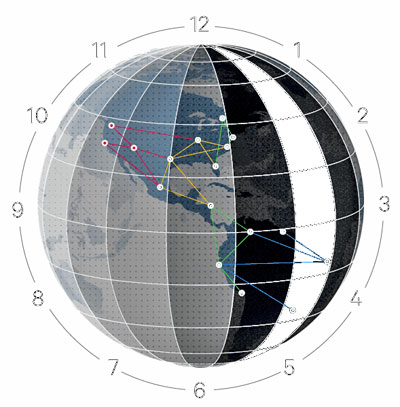|
Three years ago, a top Google engineer named Vijay Gill was asked what he would do if someone gave him a magic wand.
At the time, Gill helped run the massive network of data centers that underpins Google’s online empire, and he was sitting on stage at a conference in downtown San Francisco, discussing the unique challenges facing this globe-spanning operation.
Jonathan Heilger - the man who oversaw Facebook’s data centers - sat a few seats away, and it was Heiliger who asked Gill what he would add to Google’s data centers if he had a magic wand.
Gill hesitated before answering. And when he did answer, he was coy. But he seemed to say he would use that magic wand to build a single system that could automatically and instantly juggle information across all of Google’s data centers.
Then he indicated that Google had already built one.
It was little more than a teaser.
But about four months later, Google dropped another hint. At a symposium in the mountains of Montana, Jeff Dean - one of Google’s most important engineers - revealed that the web giant was working on something called Spanner, describing it as a “storage and computation system that spans all our data centers.”
He said the plan was to eventually juggle data across as many as 10 million servers sitting in “hundreds to thousands” of data centers across the globe.
The scope of the project was mind-boggling. But Dean provided few details, and it wasn’t clear whether Google was actually using the platform in its live data centers. Then, on Tuesday, the paper hit the web.
This week, as reported by GigaOm and ZDnet, Google published a research paper detailing the ins and outs of Spanner.
According to Google, it’s the first database that can quickly store and retrieve information across a worldwide network of data centers while keeping that information “consistent” - meaning all users see the same collection of information at all times - and it’s been driving the company’s ad system and various other web services for years.
Spanner borrows techniques from some of the other massive software platforms Google built for its data centers, but at its heart is something completely new.
Spanner plugs into a network of servers equipped with super-precise atomic clocks or GPS antennas akin to the one in your smartphone, using these time keepers to more accurately synchronize the distribution of data across such a vast network.
That’s right, Google attaches GPS antennas and honest-to-goodness atomic clocks to its servers.
Spanner may seem like an extreme undertaking, and certainly, it tackles an unusual problem.
Few other companies on Earth are forced to deal with so much data so quickly. But Google’s massive data center creations have a way of trickling down to the rest of the tech world.
The prime example is Hadoop, a widely used number-crunching platform that mimics technologies originally built at Google, and this trend will likely continue.
According to Charles Zedlewski, vice president of products at Cloudera, the company was already aware of Spanner - after recruiting some ex-Google engineers - and it may eventually incorporate ideas from the paper into its software.
Facebook is already building a system that’s somewhat similar to Spanner, in that it aims to juggle information across multiple data centers. Judging from our discussions with Facebook about this system - known as Prism - it’s quite different from Google’s creation.
But it shows that other outfits are now staring down many of the same data problems Google first faced in years past.
Jeff Dean and Sanjay Ghemawat, two of the most important engineers behind the Googlenet. Image: Wired/Ariel Zambelich
Google’s Bigger Table
The Spanner paper lists many authors, but two stand out: Jeff Dean and Sanjay Ghemawat.
After joining Google from the research operation at DEC - the bygone computer giant - Dean and Ghemawat helped design three massive software platforms that would have a major impact on the rest of the internet.
MapReduce and the Google File System gave rise to Hadoop, while BigTable helped spawn an army of “NoSQL” databases suited to storing and retrieving vast amounts of information.
Spanner draws on BigTable, but it goes much further. Whereas BigTable is best used to store information across thousands of servers in a single data center, Spanner expands this idea to millions of servers and multiple data centers.
The genius of the platform lies in something Google calls the TrueTime API.
API is short for application programming interface, but in this case, Google is referring to a central data feed that its servers plug into. Basically, TrueTime uses those GPS antennas and atomic clocks to get Google’s entire network running in lock step.
A GPS antenna taps into the Global Position System, which relies on a series of space satellites to track time and location, while an atomic clock uses the properties of individual atoms to maintain correct time.
Google declined to discuss Spanner.
But she did point to a particular portion of the paper that highlights the importance of the API.
To understand TrueTime, you have to understand the limits of existing databases.
Today, there are many databases designed to store data across thousands of servers. Most were inspired either by Google’s BigTable database or a similar storage system built by Amazon known as Dynamo. They work well enough, but they aren’t designed to juggle information across multiple data centers - at least not in a way that keeps the information consistent at all times.
According to Andy Gross - the principal architect at Basho, whose Riak database is based on Amazon Dynamo - the problem is that servers must constantly communicate to ensure they correctly store and retrieve data, and all this back-and-forth ends up bogging down the system if you spread it across multiple geographic locations.
Max Schireson - the CEO of 10gen, whose MongoDB database follows in the footsteps of BigTable - puts it a different way.
Imagine, Schireson says, that you’re using a web service to transfer money between two bank accounts, one in Europe and another in Asia. If you’re in Europe, it may look like the transfer is complete. But to someone in Asia, it might not, because there’s a delay in communication.
There may even be cases, he says, where one observer sees the money in both accounts at the same time. In short, the service may not always work as advertised because not everyone has the same view of the data. The data isn’t consistent.
If you then consider a service used by millions of people, you can see how large this problem can be.
With TrueTime, Spanner solves this problem, taking an approach that no one expected.
How to Keep TrueTime
Rather than try to improve the communication between servers, Google spreads clocks across its network.
It equips various master servers with GPS antennas or atomic clocks, and - working in tandem with the TrueTime APIs - these time keepers keep the entire network in sync. Or thereabouts.
In short, the TrueTime API taps into those master time keepers, and servers across the network tap into the API.
TrueTime then tells the servers how much “uncertainty” there is over the current time, and they can adjust their reads and writes accordingly.
Ordinary servers tap into public atomic clocks in an effort to maintain the correct time. But this method isn’t as accurate as it could be, says Gross. Google has gone a step further, installing its own atomic clocks - and GPS antennas - directly on its machines.
The system was first used to help serve ads across the Google empire, but it has seen expanded to all sorts of other Google services.
The system also helps Google replicate and move data across its network, and this helps the company accommodate data center repairs and upgrades and even ride out network problems. When he first alluded to Spanner three years ago, Vijay Gill talked of Google automatically moving vast amounts of data out of facility that needed to be temporarily shutdown because the temperature was too high.
The rub is that you can’t use Spanner unless you add hardware to your servers. In its paper, Google says the atomic clocks aren’t expensive, and 10gen’s Max Schireson can see other outfits installing similar equipment. But both Basho’s Gross and Cloudera’s Zedlewski believe the cost would be prohibitive for general use.
Gross says that building a system that relies on such equipment doesn’t make sense for an outfit like Basho. And Zedlewski says much the same thing about Cloudera.
But even they see the future in Spanner.
Like so many other NoSQL outfits, Basho aims to serve large web players and other outfits facing epic amounts of online data, and Gross says the fundamental ideas behind Spanner can help the company do that.
|


